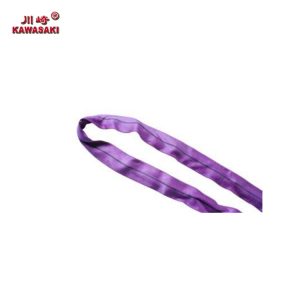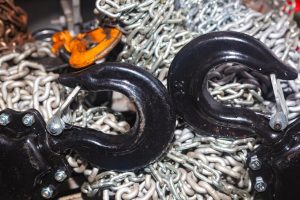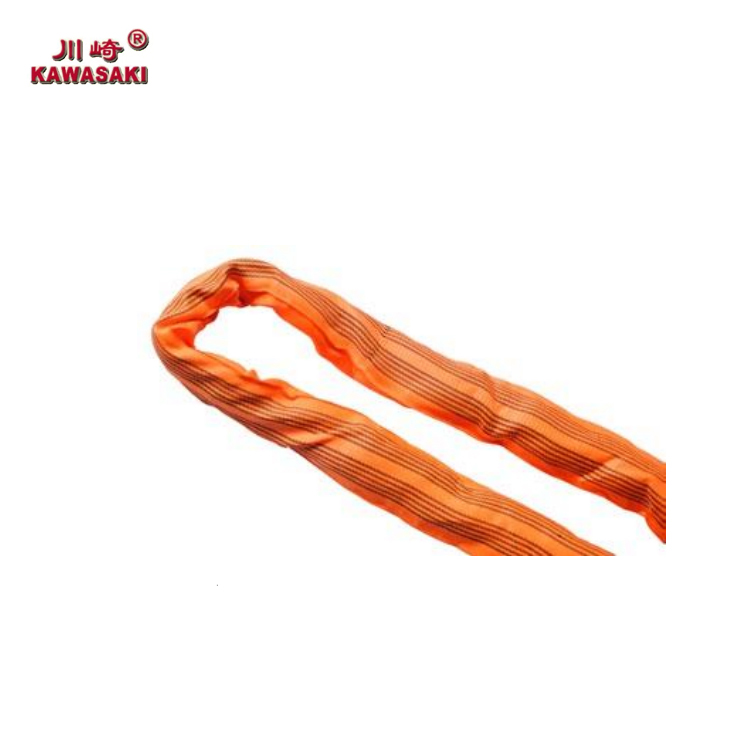Introduction
Lifting and rigging operations are fundamental across many industries, including construction, manufacturing, shipping, and logistics. At the heart of these operations is the use of slings, essential tools that connect loads to lifting devices such as cranes and hoists. Slings come in various styles and are constructed from different materials, each tailored to specific applications and environments. Choosing the correct sling style can mean the difference between a safe, efficient lift and a hazardous operation.
This article explores the different types of slings, including round slings, wire rope slings, chain slings, and synthetic web slings. It discusses the construction, advantages, limitations, and common use cases for each, providing a comprehensive guide to selecting the right sling for specific lifting applications.
1. Round Slings
Construction and Materials
Round slings are made from a continuous loop of synthetic yarns (usually polyester or high-performance fibers such as Dyneema or Kevlar) encased in a durable, tubular synthetic fabric. The inner core bears the lifting load, while the outer sheath provides protection from abrasion and environmental factors.
Advantages
-
Flexibility: Round slings are highly flexible and conform easily to irregularly shaped loads, reducing stress points.
-
Lightweight: Easier to handle compared to metal slings, making them ideal for jobs that require frequent rigging changes.
-
Non-damaging: The soft fabric surface is less likely to scratch or damage delicate or finished surfaces.
-
High strength-to-weight ratio: Despite their lightweight nature, round slings can lift several tons.
Common Applications
-
Aerospace and Automotive Manufacturing: Ideal for lifting delicate and precisely machined components.
-
Theater and Entertainment: Used to hoist trusses, lights, and sound equipment without marring surfaces.
-
General Industry: Suitable for lifting cylindrical objects like pipes, rolls, and barrels.
Limitations
-
Susceptible to cutting and abrasion: Though the outer sheath is protective, round slings must be used with edge protection or wear pads on sharp-edged loads.
-
Temperature limitations: Typically not suitable for high-temperature environments unless made from specialized fibers.
2. Wire Rope Slings
Construction and Materials
Wire rope slings are made from strands of steel wire twisted together to form a strong, flexible rope. They come in various configurations, including single-part and multi-part (braided or grommet) slings, depending on the load and application requirements.
Advantages
-
Durability: Highly resistant to abrasion and capable of withstanding harsh environments.
-
High capacity: Can handle very heavy loads, making them ideal for demanding lifting applications.
-
Variety of End Fittings: Can be customized with eyes, hooks, or thimbles to suit specific rigging needs.
Common Applications
-
Construction and Infrastructure Projects: Lifting structural steel, rebar bundles, and pre-fabricated components.
-
Maritime and Offshore: Withstanding corrosive saltwater environments.
-
Mining and Heavy Manufacturing: Ideal for rugged lifting tasks involving abrasive materials.
Limitations
-
Less flexible: More difficult to wrap around irregular shapes compared to synthetic slings.
-
Heavier: More labor-intensive to handle and store.
-
Damage prone to kinking or crushing: Improper storage or handling can degrade wire rope strength.
3. Chain Slings
Construction and Materials
Chain slings are composed of high-strength alloy steel chains and can be configured as single-leg, double-leg, triple-leg, or quad-leg slings. They often include hooks, master links, and shortening clutches.
Advantages
-
Extreme durability: Withstands high temperatures and abrasive conditions.
-
Adjustability: Chain slings can be shortened or adjusted with built-in hooks and clutches.
-
Load balancing: Multiple-leg slings offer balanced load distribution for complex lifts.
Common Applications
-
Foundries and Steel Mills: Withstand extreme heat and rough handling.
-
Construction Sites: Used for lifting concrete panels, beams, and machinery.
-
Scrap Yards and Recycling Facilities: Rugged enough for irregular and sharp-edged loads.
Limitations
-
Heaviest sling type: Requires mechanical assistance for handling in some cases.
-
Cost: Generally more expensive than synthetic or wire rope slings.
-
Corrosion: Without protective coatings, chains may rust over time in moist environments.
4. Synthetic Web Slings
Construction and Materials
Synthetic web slings are made from woven synthetic materials like polyester or nylon. They come in flat designs with eye-to-eye ends or twisted eye configurations for versatile rigging setups.
Advantages
-
Lightweight and easy to handle: Can be quickly positioned and removed, improving job efficiency.
-
Non-damaging to loads: Ideal for lifting items with finished or painted surfaces.
-
Variety: Available in various lengths, widths, and capacities, often color-coded for easy identification.
Common Applications
-
Warehouse and Distribution: Handling boxed or palletized goods.
-
Aircraft and Marine Industry: Ideal for lifting composite or delicate materials.
-
Maintenance and Light-Duty Applications: Where frequent sling changes are required.
Limitations
-
Lower durability: Prone to damage from cuts, UV exposure, and chemicals.
-
Limited heat resistance: Not suitable for high-temperature operations.
-
Load deformation: Can stretch under heavy loads, which may affect load control.
5. Comparison of Sling Types
| Sling Type | Material | Flexibility | Durability | Temperature Resistance | Load Capacity | Ideal For |
|---|---|---|---|---|---|---|
| Round Sling | Synthetic (polyester, Dyneema) | High | Moderate | Low to Moderate | High | Delicate or irregular loads |
| Wire Rope Sling | Steel wire | Moderate | High | High | Very High | Heavy-duty, outdoor lifts |
| Chain Sling | Alloy steel | Low | Very High | Very High | Extremely High | Harsh, abrasive environments |
| Web Sling | Synthetic (nylon, polyester) | Very High | Low to Moderate | Low | Moderate | Fragile surfaces, indoor lifts |
6. Sling Selection Criteria
When choosing a sling for a particular lifting operation, several key factors must be considered:
Load Characteristics
-
Weight and Center of Gravity: Ensure the sling’s Working Load Limit (WLL) exceeds the load’s total weight.
-
Shape and Fragility: Use soft, conforming slings for fragile or uniquely shaped items.
Environmental Conditions
-
Temperature: Chain and wire slings perform better under high temperatures than synthetics.
-
Moisture and Chemicals: Use slings with appropriate resistance to chemicals and corrosion.
-
UV Exposure: Prolonged sun exposure can degrade synthetic slings.
Frequency of Use
-
High-frequency operations may justify the use of more durable slings like wire rope or chains.
-
Light-duty or temporary lifts can benefit from the speed and ease of synthetic slings.
Rigging Configuration
-
Choose between vertical, choker, or basket hitches, considering how the load is to be lifted and secured.
7. Inspection and Maintenance
Regardless of type, slings must be regularly inspected for signs of wear, damage, or fatigue:
-
Synthetic slings: Check for cuts, burns, abrasions, or stitching failure.
-
Wire rope slings: Look for broken wires, crushing, corrosion, or kinks.
-
Chain slings: Inspect for elongation, corrosion, cracks, or deformation.
Always follow the manufacturer’s guidelines and OSHA/ASME standards for retirement criteria and record keeping.
Conclusion
Slings play a critical role in lifting operations across a multitude of industries. From the soft touch of a round sling to the rugged resilience of a chain sling, each type offers unique benefits tailored to specific applications. A clear understanding of sling styles, their capabilities, and their limitations allows rigging professionals to select the right equipment, ensuring not only efficiency but, most importantly, safety.
As industries grow and lifting technologies evolve, the importance of matching the correct sling to the right application remains constant. Proper sling selection, combined with thorough inspection and maintenance practices, forms the cornerstone of a safe and effective lifting operation.

